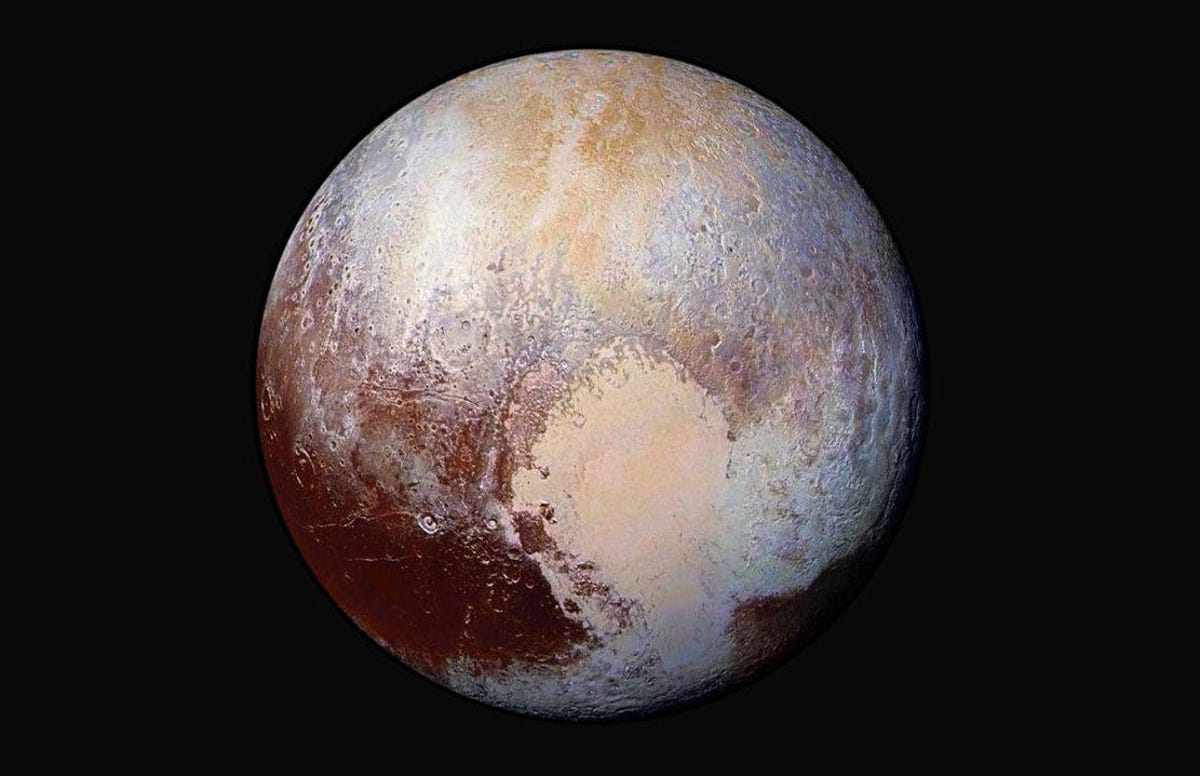NASA spots odd heart-shaped objects on Mars and beyond
NASA is feeling the cosmic love, and Mars is a hotspot for otherworldly hearts.

Pluto's heart
NASA loves space and sometimes space seems to love it right back. The agency's spacecraft and explorers have seen all sorts of hearts in surprising places, from the surface of Mars to a wide swathe of dwarf-planet Pluto.
NASA's New Horizons spacecraft visited Pluto in 2015. This enhanced-color view shows off Pluto's distinctive heart, a bright surface feature that stands out from its darker surroundings.
Ridged heart on Mars
This lopsided heart is a bit of a Mars mystery. NASA's Mars Reconnaissance Orbiter snapped a look at it in 2014. The ridges around the heart are particularly interesting. The whole feature rises above the surrounding landscape.
The heart is located south of the volcano Ascraeus Mons. NASA says "it is extremely likely that this feature was formed by a volcanic process." Scientists also likened its shape to that of a rubber ducky.
Apollo 12 heart
The Apollo 12 mission in 1969 gave us a lot of good views of the moon's surface. This particular shot shows a heart-shaped crater. The full image also shows the legs of NASA astronaut Charles Conrad Jr.
Sweet spot on Mars
NASA's Mars Reconnaissance Orbiter found this heart-shaped feature on Mars in 2010. A small impact crater at the bottom of the heart created the lovely formation. When rocks impact Mars, they blast away the darker surface material. This one just happened to make a heart shape.
Heart mesa on Mars
It's not just impact craters on Mars that resemble hearts. This cute feature is a mesa seen by NASA's Mars Global Surveyor in 1999. The mesa is located in the planet's south polar region. If it looks like an indentation rather than rise, then that's just a visual trick of the eyes due to the way the sunlight reflects off the mesa.
Heart lake from the ISS
European Space Agency astronaut Thomas Pesquet looked down from the International Space Station in 2017 and captured a photo of this heart-shaped lake from orbit. Pesquet shared it just in time for Valentine's Day that year.
Curiosity heart light
This cheerful little patch of sunlight arguably looks like a heart (or a rocking horse without its rockers). NASA's Curiosity rover snapped this view in 2012. NASA says the heart-shaped bit of light "reminds us of how we love learning about Mars."
Vesta's hollow heart
NASA's Dawn spacecraft visited giant asteroid Vesta in 2011 and the agency shared this hearty image for Valentine's Day in 2012. The processed image uses colors to represent changes in the height of the topography. The blue heart is a hollow that is 6 miles (10 kilometers) across at its widest point.
NASA retired Dawn in late 2018.
Pit of my Mars heart
NASA's Mars Global Surveyor was really feeling the love from the Red Planet when it snapped this picture of heart-shaped pit in 1999. The space agency says this is "actually a pit formed by collapse within a straight-walled trough known in geological terms as a graben."
Pit of Mars heart
This heart is the pits. NASA's Mars Reconnaissance Orbiter spacecraft snapped its picture in 2008. The heart-shaped pit is located next to an area of Mars called Hydaspis Chaos, which NASA describes as "a jumbled topographic depression." At least the heart is cheery.
Mars Yard heart
This heart is a little more down to Earth. NASA engineers discovered it in the Jet Propulsion Laboratory's Mars Yard just before Valentine's Day in 2014. The space agency uses the Mars Yard to test a copy of the Curiosity rover on Earth.
Mars heart odyssey
NASA's 2001 Mars Odyssey spacecraft snapped this look at yet another heart-shaped mesa on the Red Planet and shared it for Valentine's Day in 2006. Odyssey is the agency's longest-lasting Mars spacecraft. It arrived to orbit the planet in 2001. Its name is a tribute to sci-fi writer Arthur C. Clarke.
Heart in the darkness
This amorphous-looking set of cosmic formations shows young star cluster NFC 346 as seen by NASA's Chandra X-ray Observatory. A heart shape emerges at the center.
"Evidence from radio, optical and ultraviolet telescopes suggests that the hot cloud, which is about 100 light years across, is the remnant of a supernova explosion that occurred thousands of years ago," says NASA. The space agency released the Chandra image in 2003.
Christie's auctions The Heart of Space
Christie's auction house made plans to put this heart-shaped meteorite up for bid on Feb. 6, 2019. The unusual meteorite weighs over 22 pounds (10 kilograms) and arrived on Earth after a fireball streaked across Siberia in 1947. It is nicknamed "The Heart of Space."
Surveying a Mars heart
This may be the least-cheery heart NASA has seen on Mars. It comes from a 2005 Mars Global Surveyor image. The space agency describes it as "a heart-shaped hill surrounded by cracked terrain within a depression in far northwestern Arabia Terra."

